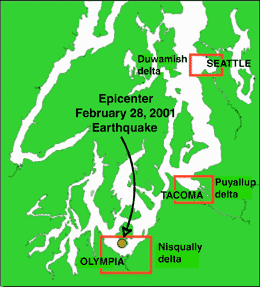Welcome to the epicenter of the 2001 Nisqually Earthquake, a pivotal location that tells a story of geological power and human resilience. Nestled in the southern Puget Sound region of Washington State, this area is a testament to the dynamic forces shaping our planet.
On February 28, 2001, at precisely 10:54:32 AM, the earth trembled with a force that left a lasting impact on the Pacific Northwest. The Nisqually Earthquake, with a magnitude of 6.8, was an intraslab earthquake deep within the Juan de Fuca plate, which lies beneath the North American plate. This seismic event affected areas as far-reaching as Oregon, British Columbia, eastern Washington, and Idaho.
The earthquake caused extensive property damage, estimated between $1 and $4 billion, disrupting lives and infrastructure. In cities like Olympia and Seattle, iconic structures such as the Alaskan Way Viaduct and the dome of the state capitol bore the brunt of the quake. In the aftermath, the Alaskan Way Viaduct’s damage led to its eventual replacement with the SR 99 Tunnel, designed to withstand future seismic events.
The Puget Sound region has a history of seismic activity due to its location in the Cascadia subduction zone, where the Juan de Fuca plate is slipping beneath the North American plate. This area has witnessed several significant earthquakes, including those in 1949 and 1965, both with magnitudes of 6.7.
In the broader historical context, the 2001 Nisqually Earthquake serves as a reminder of the natural forces at play in the Pacific Northwest. It also highlights the importance of earthquake preparedness and resilient infrastructure. This quake prompted changes in building codes and led to increased awareness about the need for seismic retrofitting.
As you stand here, consider the stories of the people who experienced this tremor—a moment that shook buildings and lives yet also united communities in recovery and rebuilding. The 2001 Nisqually Earthquake is not just a historical event but a chapter in the ongoing narrative of the human relationship with the earth.






